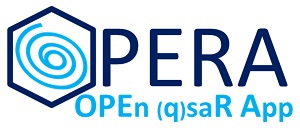OPERA
Open (Quantitative) Structure-activity/property Relationship App

Quantitative structure–activity/property relationship (QSAR/QSPR) models provide predictions of chemical activity that can augment non-animal approaches for predicting toxicity. However, the performance of QSAR models highly depends on the quality of the data and modeling methodologies used.
The Open (Quantitative) Structure-activity/property Relationship App (OPERA) (Mansouri et al. 2018) is a free and open-source/open-data suite of QSAR models providing predictions for toxicity endpoints and physicochemical, environmental fate, and ADME properties. OPERA was created in alignment with rigorous OECD standards to provide a regulatory-oriented alternative to experimental measurements. All OPERA models were built on curated data (Mansouri et al. 2016) and QSAR-ready chemical structures standardized using an open-source workflow implemented in the application (Mansouri et al. 2024).
OPERA is an ongoing collaboration between NICEATM and EPA. Additions to OPERA include predictions for:
- Estrogenic activity from the Collaborative Estrogen Receptor Activity Prediction Project (CERAPP) (Mansouri et al. 2016).
- Androgenic activity from the Collaborative Modeling Project for Androgen Receptor Activity (CoMPARA) (Mansouri et al. 2020).
- Acute oral systemic toxicity from the Collaborative Acute Toxicity Modeling Suite (CATMoS) (Mansouri et al. 2021)
- Physicochemical properties such as acid dissociation constant (pKa) and octanol-water dissociation coefficient (logD) (Mansouri et al. 2019).
Other endpoints predicted by OPERA models include:
- Physicochemical parameters such as octanol-water partition coefficient (logP), water solubility, and melting point.
- Parameters for inputs into pharmacokinetic models, such as hepatic clearance, plasma fraction unbound, and Caco-2 intestinal cell permeability (logPapp).
- Ecotoxicity parameters such as fish bioconcentration factor (logBCF), soil adsorption coefficient (KOC), and biodegradability.
The OPERA application can be downloaded from the NIEHS GitHub repository and used locally on your desktop. Command-line and graphical user interface versions of OPERA are available for Windows and Linux operating systems. In addition to the prepackaged installer, the GitHub repository includes the code, the data, and QSAR model reporting format (QMRF) reports. OPERA can generate predictions for single chemicals or in batch mode, and returns predictions with accuracy assessments, confidence ranges, and experimental values where available.
OPERA predictions of toxicity and physicochemical properties are also available through the Integrated Chemical Environment (ICE), the EPA CompTox Chemicals Dashboard, and the PrecisionFDA platform. OPERA is also now available as an extension to QSAR Toolbox, a tool co-developed by ECHA and OECD to support animal-free chemical hazard assessment.